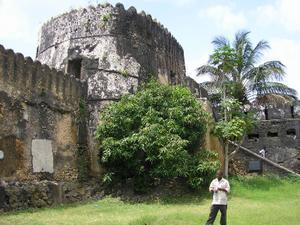Advertisement
Published: December 3rd 2005

 Portugese Fort
Portugese Fort
The Portugese is now a ruin, but before it was used as a prison as well as a fort. George, my guide is the person in the photo.My second day on Zanzibar has gone very well, I have been shown around Stone Town, getting a feel for the place and learning a lot about its history. Stone Town has quite an international feel to it, obviously it is in Africa, but as a major trading centre, it has been influenced by various foreign powers over time. The Portuguese were the first European power to reach Zanzibar, and they built a fort, which still stands, although it is now a ruin. They also left a few words in the Swahili language, although in reality, there power here was never that strong.
Omani Arabs ruled here for quite some time, there was a Sultan of Zanzibar right up until the revolution in the sixties, however in the final years the British had the real power. There are many Arab influences in the buildings, with buildings such as the House of Wonders, the former palace (now a museum) bearing testament to the time of their rule. There are also many words of Arabic origin used in Swahili (although the grammar is of Bantu (African) origin). Many of the famous Zanzibari doors date back to this time. The British and the

 Sculpture
Sculpture
This sculpture was made to commemerate the slaves, using an original chain. It was made by a Swedish artist whose name I cannot remember.Germans both tried to gain power here, and both built embassies to try to influence the Omani Sultans. Germany in fact controlled the mainland until the first world war but exchanged any claim to power on Zanzibar for a small island somewhere in the North Sea.
The British influence managed to end the slave trade here, using the Royal Navy to intercept slave ships, and they also drained a creek, that effectively cut off Stone Town from the rest of the Island. The site of the Cathedral (built under the supervision of Bishop Steere), is the site of the former Slave Market, with the High Altar at the spot of the Whipping Post (they would whip the slaves to see how strong they were). I also saw the cells where 75 slaves would be kept in just a tiny room, with no light, food or drink. There is also a window to commemorate Dr David Livingstone, whose reports on slavery in Africa helped to bring about the abolition, as well as a cross made from a branch of the tree beneath which his heart was buried in Zambia (his body was brought back to Britain).
I also visited

 Cathedral
Cathedral
This is the Anglican Cathedral, built on the site of the former slave market, under the supervision of Bishop Edward Steere. An interesting random fact is the pillars inside where placed the wrong way up, as the Bishop was away when they were erected, and by the time he came back, it was too late to change them.the market, where you can buy many different fruits, vegetables, fish, meat and spices. In Zanzibar there are stalls not just in the market, but also in the streets, people will come up to you and try to sell you things. Sipendi and hapana ansante are vital words to know here. The narrow streets of Stone Town are very pleasant to walk around, but the narrowness does not stop people trying to use motorcycles or bikes to get around them, you have to be careful to get out of the way.
I ate out at lunch, this time in very much a local restaurant/cafe, and enjoyed ndizi na samaki (bananas and fish), with pineapple juice, the meals and drinks for both me and my guide came to less than 5GBP, and there was more than either of us could eat. Sugar cane juice is also a bargain (as well as delicious) at 150 shillingi (7.5 pence) per cup.
Although there are many old buildings in Stone Town, and some of them are well maintained, others are not, and flaking paint or damage to houses is a common site. Stone Town has now been made a World Heritage Site

 Market
Market
The market is bright, colourful and noisy, although a little smelly (they also sell fish there).though, and efforts are being made to conserve it.
I finished off the day with a walk along one of the beautiful beaches, complete with palm trees and golden sand.
Advertisement
Tot: 0.131s; Tpl: 0.01s; cc: 9; qc: 48; dbt: 0.0955s; 1; m:domysql w:travelblog (10.17.0.13); sld: 1;
; mem: 1.1mb

 Portugese Fort
Portugese Fort
 Sculpture
Sculpture
 Cathedral
Cathedral
 Market
Market
